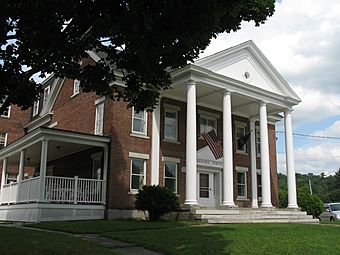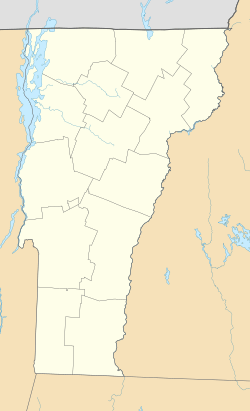Barre Downtown Historic District facts for kids
Quick facts for kids |
|
|
Barre Downtown Historic District
|
|
 |
|
| Location | US 302, Barre, Vermont |
|---|---|
| Area | 25 acres (10 ha) |
| Built | 1875 |
| Architectural style | Italianate, Queen Anne, Greek Revival |
| NRHP reference No. | 79000227 |
| Added to NRHP | September 4, 1979 |
The Barre Downtown Historic District is a special area in the city of Barre, Vermont. It includes the main streets where businesses and important city buildings are located. This area grew very quickly in the 1880s and 1890s. This was because the nearby granite quarries became very busy. The district was added to the National Register of Historic Places in 1979. This means it is a place worth protecting because of its history.
Contents
Discovering Barre's Historic Heart
Barre used to be a small farming town. But everything changed in 1875 when the Central Vermont Railway connected it to the national train system. People had been digging granite from the hills around Barre since the early 1800s. However, the arrival of the railroad, and another train line directly to the quarries in 1888, made the granite business boom!
How Barre Grew with Granite
This growth turned Barre from a quiet village into a busy city. It officially became a city in 1895. Many of the commercial and civic buildings you see today were built between 1880 and 1925. These buildings line North Main Street and City Park. They show how important the granite industry was to Barre's development.
Exploring the District's Layout
The historic district mainly stretches along North Main Street (which is also US 302). It goes from Depot Square to City Park. City Park is a triangle-shaped park. It is surrounded by important city and religious buildings. These buildings mark the southeastern end of the district.
Even though granite was super important to Barre, most buildings are made of brick. They show off different building styles. You can see older Italianate buildings from the 1880s. There are also Classical Revival and Romanesque buildings from the 1890s and 1900s. The Miles Block, built in 1898, is special. It uses a lot of local granite in its design.
Important Buildings in the District
Many buildings in the district are called "contributing properties." This means they help make the area historically important. Some of these buildings include:
- First Baptist Church, located at 24 Washington Street
- Hedding Methodist Church, found at 40 Washington Street
- Masonic Temple, at 2 Academy Street
- Quinlen Block, located at 170-174 N. Main Street
- Aldrich Building, a unique trapezoidal building at 47 N. Main Street
- Barre City Hall and Opera House, a key civic building
- Aldrich Public Library, an important community resource
Gallery
Images for kids







